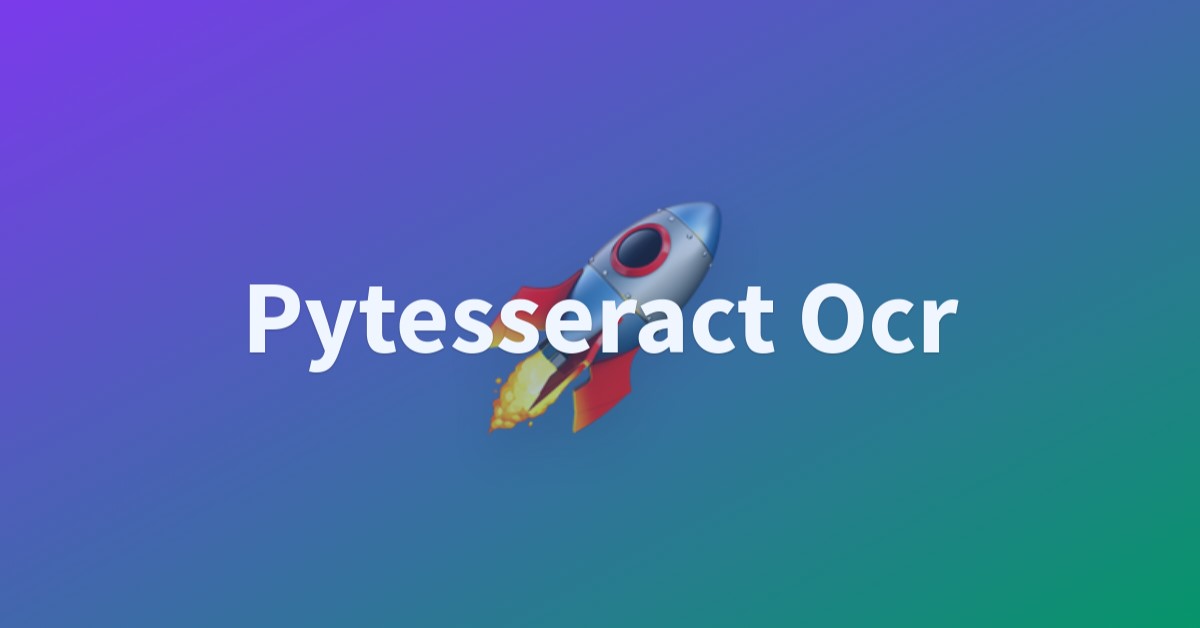
Pytesseract is a powerful tool that bridges the gap between Python and Google's Tesseract-OCR engine. But what exactly makes it so special? Pytesseract allows developers to extract text from images with ease, making it a go-to for tasks like digitizing documents, reading license plates, or even analyzing handwriting. Imagine turning a photo of a book page into editable text in seconds! This tool is not just for tech wizards; anyone with basic Python knowledge can harness its capabilities. Ready to dive into the world of Pytesseract? Let's uncover 19 fascinating facts that will show you why this tool is a game-changer.
What is Pytesseract?
Pytesseract is a Python library that helps with Optical Character Recognition (OCR). It allows users to extract text from images. This tool is widely used for various applications, from digitizing documents to reading text from photos.
-
Pytesseract is a wrapper for Google's Tesseract-OCR Engine. It makes the powerful OCR capabilities of Tesseract accessible through Python.
-
Tesseract itself was originally developed by Hewlett-Packard in the 1980s. It has since become open-source and is maintained by Google.
-
OCR stands for Optical Character Recognition. It is a technology that converts different types of documents, such as scanned paper documents, PDFs, or images taken by a digital camera, into editable and searchable data.
How to Install Pytesseract
Installing Pytesseract is straightforward. You need to have Python and Tesseract-OCR installed on your system.
-
You can install Pytesseract using pip, a package manager for Python. The command is
pip install pytesseract. -
Tesseract-OCR must be installed separately. On Windows, you can download the installer from the official Tesseract website. For Linux, you can use a package manager like
aptoryum. -
After installation, you need to configure the path to the Tesseract executable in your Python script. This is done using
pytesseract.pytesseract.tesseract_cmd.
Basic Usage of Pytesseract
Once installed, using Pytesseract is simple. You can start extracting text from images with just a few lines of code.
-
To read text from an image, you first need to import the library using
import pytesseract. -
Load the image using a library like PIL (Python Imaging Library) or OpenCV. For example,
from PIL import Imageandimage = Image.open('path_to_image'). -
Use the
image_to_stringfunction to extract text. For example,text = pytesseract.image_to_string(image).
Advanced Features of Pytesseract
Pytesseract offers several advanced features that can enhance its functionality.
-
You can specify the language for OCR. This is done using the
langparameter in theimage_to_stringfunction. For example,text = pytesseract.image_to_string(image, lang='eng'). -
Pytesseract supports multiple languages. You can specify more than one language by separating them with a plus sign. For example,
text = pytesseract.image_to_string(image, lang='eng+fra'). -
You can extract text from specific regions of an image. This is done using the
boxparameter. For example,text = pytesseract.image_to_string(image, box=(left, top, right, bottom)).
Pytesseract in Real-World Applications
Pytesseract is used in various real-world applications, making it a versatile tool.
-
It is used in document digitization projects. This helps in converting paper documents into digital formats, making them searchable and editable.
-
Pytesseract is also used in data extraction from forms and invoices. This helps in automating data entry tasks.
-
It is used in the development of assistive technologies. For example, it can help visually impaired individuals by reading text from images aloud.
Limitations of Pytesseract
While Pytesseract is powerful, it has some limitations.
-
The accuracy of OCR depends on the quality of the input image. Poor quality images can lead to incorrect text extraction.
-
Pytesseract may struggle with complex layouts. For example, it may not correctly interpret text from images with multiple columns or mixed text and graphics.
-
It has limited support for handwritten text. Pytesseract works best with printed text and may not accurately recognize handwritten characters.
Future of Pytesseract
The future of Pytesseract looks promising, with ongoing developments and improvements.
- Continuous updates to the Tesseract-OCR engine enhance its capabilities. This means that Pytesseract will benefit from these improvements, making it even more powerful and accurate.
Final Thoughts on Pytesseract
Pytesseract is a game-changer for anyone needing text extraction from images. It’s an open-source Python library that leverages Google’s Tesseract-OCR Engine. This tool is versatile, supporting multiple languages and various image formats. Whether you’re working on a personal project or a professional task, Pytesseract can save you loads of time and effort.
Its ease of use makes it accessible even for beginners. Just a few lines of code can convert complex images into readable text. Plus, the community support around Pytesseract is robust, offering plenty of resources and troubleshooting help.
Incorporating Pytesseract into your workflow can streamline processes and enhance productivity. So, if you haven’t tried it yet, now’s the time to explore its capabilities. You might be surprised at how much it can simplify your tasks.
Was this page helpful?
Our commitment to delivering trustworthy and engaging content is at the heart of what we do. Each fact on our site is contributed by real users like you, bringing a wealth of diverse insights and information. To ensure the highest standards of accuracy and reliability, our dedicated editors meticulously review each submission. This process guarantees that the facts we share are not only fascinating but also credible. Trust in our commitment to quality and authenticity as you explore and learn with us.


